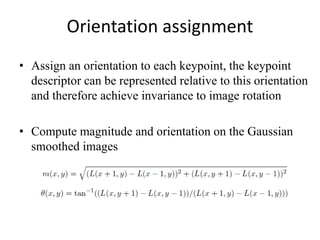project_PPT_final
- 1. LANDMARK BASED IMAGE REGISTRATION USING THIN PLATE SPLINE WITH FEATURE MATCHING Under the Guidance of Mr. Soumik Ghosh Assistant Professor, UIT,Golapbag,Burdwan Prepared By: Ranjan Ganguli ME2014-10014 Master of engineering Department of Computer Science and Engineering University Institute of Technology Golapbag,Burdwan
- 2. Objective • The purpose of this project is to produce deformation of an input image using set of landmark points and making a correspondence between them. Application: medical image processing, robotics
- 3. Review for Thin Plate Spline • Rigid-body alignment • Non-rigid deformation – Intrinsic methods: deforming the boundary points – An optimization problem • Minimize shape distortion • Maximize fit, smoothing After Before Source Target
- 4. Thin Plate Spline deformation Technique Analogues to bending a thin sheet of metal extending to infinity[1]
- 5. Thin-Plate Spline • Given corresponding source and target points • Computes a deformation function for every point in the 2D plane.
- 6. • Input – Source points(black): p1,…,pn – Target points(gray): q1,…,qn • Output – A deformation function f[p] for any point p..[2] Thin-Plate Spline pi qi f[p]
- 7. • Distortion or Bending Energy equation: - Integral of second order partial derivatives along x and y axis[3]. Thin-Plate Spline
- 8. How to Solve this Equation?
- 9. Need to solve various matrix equations
- 10. • Thus ,the solution to this bending energy equation: f(x,y) gives the surface heights of mapping all points in the plane[1]. Thin-Plate Spline
- 11. Final deformed or warped image with a set of landmark points Thin Plate Spline Original image Deformed image Blue dots represent the landmark points
- 12. How to match “Feature Points“ between deformed image and original image?
- 13. Matching Feature Points Technique: • Developed by David Lowe • University of British Columbia • Initial paper ICCV 1999 • Newer journal paper IJCV 2004 SIFT(SCALE INVARIANT FEATURE TRANSFORM)
- 14. Overall Procedure at a High Level 1. Scale-space extrema detection 2. Keypoint localization 3. Orientation assignment 4. Keypoint description Search over multiple scales and image locations. Fit a model to determine location and scale. Select key points based on a measure of stability. Compute best orientation(s) for each key point region. Use local image gradients at selected scale and rotation to describe each key point region.
- 15. Scale-space extrema detection • Find the points, whose surrounding patches (with some scale) are distinctive. • An approximation to the scale-normalized Laplacian of Gaussian (LoG)
- 16. Maxima and minima in a 3*3*3 neighborhood
- 17. Keypoint localization • There are still a lot of points, some of them are not good enough. • The locations of key points may be not accurate. • Eliminating edge points.
- 18. Eliminating edge points • Such a point has large principal curvature across the edge but a small one in the perpendicular direction • The principal curvatures can be calculated from a Hessian function • The eigenvalues of H are proportional to the principal curvatures, so two eigenvalues shouldn’t diff too much
- 20. Orientation assignment • Assign an orientation to each keypoint, the keypoint descriptor can be represented relative to this orientation and therefore achieve invariance to image rotation • Compute magnitude and orientation on the Gaussian smoothed images
- 21. Orientation assignment • A histogram is formed by quantizing the orientations into 36 bins; • Peaks in the histogram correspond to the orientations of the patch; • For the same scale and location, there could be multiple keypoints with different orientations;
- 23. Feature descriptor • Based on 16*16 patches • 4*4 subregions • 8 bins in each subregion • 4*4*8=128 dimensions in total
- 25. Feature matching
- 26. Conclusion This paper includes non-rigid based image registration using Thin Plate Spline with Feature Matching. Landmark has been selected either manually through mouse or can be assigned initially. SIFT helps deformed image illumination, scale independent and matched with various other images. Thus this process can widely applicable to medical imaging , object identification ,robotics etc where object are at different positions all the time
- 27. Future Scope • Method 1. Gauss-Newton Method Advantage: Easy to converge for small number of points. 2. - Quasi-Newton Method Advantage: Does not require calculation of image gradient How do we get the original image from a deformed image? ( Optimization)
- 28. Idea of Optimization Pk+1 = Pk + ak.gk. The value of ‘a’ and ‘g’ has to be calculated -Gauss-Newton method -Newton Quasi method
- 29. References [1]F. L. Bookstein, “Principal warps: Thin-plate splines and the decomposition of deformations,” IEEE Trans. Pattern Anal. Machine. Intell. [2] Wahba, G. (1979). How to smooth curves and surfaces with splines and cross-validation. Proc. 24th Conference on the Design of Experiments. [3] Broomhead, David H.; Lowe, David (1988). "Multivariable Functional Interpolation and Adaptive Networks" (PDF). Complex Systems.
- 30. Thanks!



![Thin Plate Spline deformation
Technique
Analogues to bending a thin sheet of metal extending to infinity[1]](https://image.slidesharecdn.com/30669647-5530-4d0d-8b76-84336832cdc8-160903030630/85/project_PPT_final-4-320.jpg)

![• Input
– Source points(black): p1,…,pn
– Target points(gray): q1,…,qn
• Output
– A deformation function f[p] for any point p..[2]
Thin-Plate Spline
pi
qi
f[p]](https://image.slidesharecdn.com/30669647-5530-4d0d-8b76-84336832cdc8-160903030630/85/project_PPT_final-6-320.jpg)
![• Distortion or Bending Energy equation:
- Integral of second order partial derivatives
along x and y axis[3].
Thin-Plate Spline](https://image.slidesharecdn.com/30669647-5530-4d0d-8b76-84336832cdc8-160903030630/85/project_PPT_final-7-320.jpg)


![• Thus ,the solution to this bending energy equation:
f(x,y) gives the surface heights of mapping all points
in the plane[1].
Thin-Plate Spline](https://image.slidesharecdn.com/30669647-5530-4d0d-8b76-84336832cdc8-160903030630/85/project_PPT_final-10-320.jpg)


















![References
[1]F. L. Bookstein, “Principal warps: Thin-plate splines and the decomposition
of deformations,” IEEE Trans. Pattern Anal. Machine. Intell.
[2] Wahba, G. (1979). How to smooth curves and surfaces with splines and
cross-validation. Proc. 24th Conference on the Design of Experiments.
[3] Broomhead, David H.; Lowe, David (1988). "Multivariable Functional
Interpolation and Adaptive Networks" (PDF). Complex Systems.](https://image.slidesharecdn.com/30669647-5530-4d0d-8b76-84336832cdc8-160903030630/85/project_PPT_final-29-320.jpg)
